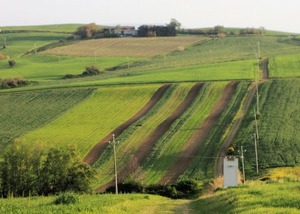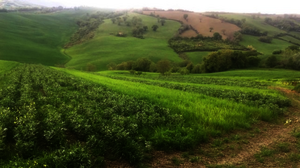Case study 22: Italy: Cereal-vegetable systems for food quality
Cluster 5: Diversification of vegetable cropping systems
In order to respond to concerns related to income diversification and consolidation, the case study mainly focused on technical, organisational and promotional aspects revolving around the adoption of strip cropping in organic farms in the Mid-Adriatic regions (Marche and Abruzzo, Italy). Strip cropping, a novelty for the territory and farming community, was identified as a positive evolution of usual practices carried out in the regions and as a valuable approach to mitigate soil erosion through differentiated soil coverage across the year. Strip cropping was meant to increase soil biodiversity and cover leading to the broadening of the crop range, to the diversification of sales channels and to greater diversity in the farming landscape.
What were the main problems underlying the emergence of the case study?
The case study was largely triggered by several underlying problems: farm income uncertainties, limited options to add value to minor crops, the need to trigger a greater sense of community through local foods and the pursuit of improved technical options for organic management of arable and vegetable crops. Similarly, the opportunities in the area were also instrumental in designing the case study, e.g., promising dynamics on local value chains, a vibrant local gastronomic heritage, tourism in the area, and the versatility of soils that energise organic farmers in the regions.
How was the problem addressed and which actors were involved?
The case study idea originated from researchers, who are in constant yet irregular contact with farms in the regions, to respond to concerns related to income diversification and consolidation. The idea was then shared with a group of farmers and ASR (Associazione Sviluppo Rurale), who took the initial case study lead (this was later taken over by FIRAB). Minor crops cultivated through strip cropping and targeted to local/short value chains were seen as a good opportunity, particularly to keep the added value at the farm level.
The case study specifically addressed key technical issues such as availability of proper organic seed varieties, suitable rotations at both agroecological and economic levels, mechanization of the strips (particularly in hilly parcels) and a widespread cultural resistance to innovation.
To achieve the outcomes envisaged during the vision and mission definition process, key stakeholders were identified as functional to the case study development as well as potential beneficiaries of its deployment: small and medium-scale farms (organic and non-organic), millers, bakers for bakery trials, pastry makers (e.g. those using chickpea flour), and small-scale seed companies providing minor crops.
Solutions investigated
The introduction of intercropping and strip cropping was seen as an evolution of more common practices carried out in the targeted regions, especially by organic farmers who represent the bulk of the co-innovators involved in the case study. Such innovative cropping systems are intended to increase soil coverage across the year and broaden the crop range, diversifying marketing channels and options. This finally enables retention of added value at the farm level.
Cooperation with the DiverIMPACTS Field Experiment 9, which focuses on strip cropping in flat conditions (rather than the hilly conditions of the involved farms), was deemed crucial to benefit from guidance and technical-scientific support.
Expected outcome
The clear case study entry point was farm income, but a more genuine agroecological approach was also deemed pivotal, as the involved organic farms were interested in developing solutions through the farming system redesign rather than just carrying out input substitution.
The collection and evaluation of a rich set of data was deemed essential to assess how strip cropping could contribute to the DiverIMPACTS goals and to provide evidence about the technical, economic and environmental benefits related to strip cropping. Field days were organized to more widely discuss approaches and results and to spread information about the pilot activities to generate and improve cooperation with other territorial agents, notably those operating in short value chains and local catering.
Mitigation of technical (particularly at the mechanisation level) and organisational constraints was also seen as crucial to trigger the adoption and scalability of the strip cropping technique. The achievement of a proper balance between performance advantages and management complexity for farmers was deemed as a critical element of analysis at the process level.
Relevance to the DiverIMPACTS goals
The case study contributed to the understanding of strip cropping in hilly conditions to improve (agro)biodiversity and the economic competitiveness of farmers. Results and farmers’ appreciation of the technique are compared with the outcomes achieved in Field Experiment 9 to analyse differences and similarities in terms of management and agro-environmental effects between a research station in flat conditions and economic farms in more difficult operational settings.
Case study legacy
In its development, the case study involved a broad range of local actors, raising interest in strip cropping and in its potential outcomes. Towards the end of the DiverIMPACTS activities, some of the case study members (one organic farm as well as FIRAB and CREA) joined forces with other local farms, scientific institutions and advisory agents to set up an EIP-AGRI Operational Group to further develop strip cropping in the Marche region over three years.
The operational group proposal was evaluated as the second best in terms of contents among the 36 submitted and, pending its administrative assessment and final approval, it would likely present concrete opportunities to test operational conditions for strip cropping. Moreover, as the case study farmers pointed out that strip cropping is not considered eligible under ordinary Common Agricultural Policy (CAP) payment formulas, the operational group will devote due attention to identify administrative and bureaucratic options for acknowledging strip cropping as a valuable agro-environmental practice that needs to be listed among those eligible for public payment. The operational group will also invite local residents and tourists to judge the strip cropping landscape contribution and value to have a sort of social endorsement for such innovative cropping practice.
Further information
Links
- zenodo.org: The introduction of strip cropping into the mid-Adriatic region
- zenodo.org: L'introduzione della coltivazione a strisce nel Medio Adriatico
Contact
- Luca Colombo, FIRAB, case study leader
- Marco Seghetti and Stefano Dell’Anna, FIRAB, case study monitors


 tap and then scroll down to the Add to Home Screen command.
tap and then scroll down to the Add to Home Screen command.